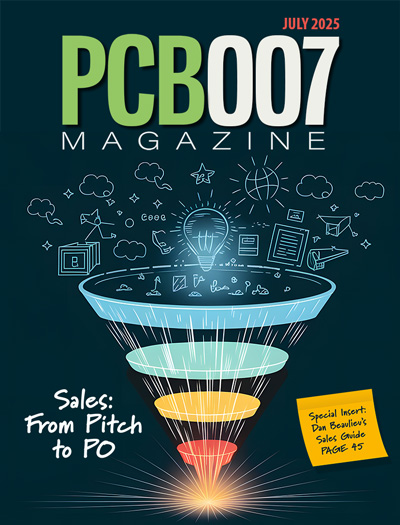-

- News
- Books
Featured Books
- pcb007 Magazine
Latest Issues
Current Issue
Advancing the Advanced Materials Discussion
Moore’s Law is no more, and the advanced material solutions to grapple with this reality are surprising, stunning, and perhaps a bit daunting. Buckle up for a dive into advanced materials and a glimpse into the next chapters of electronics manufacturing.

Inventing the Future With SEL
Two years after launching its state-of-the-art PCB facility, SEL shares lessons in vision, execution, and innovation, plus insights from industry icons and technology leaders shaping the future of PCB fabrication.

Sales: From Pitch to PO
From the first cold call to finally receiving that first purchase order, the July PCB007 Magazine breaks down some critical parts of the sales stack. To up your sales game, read on!
- Articles
- Columns
- Links
- Media kit
||| MENU - pcb007 Magazine
Optical Transceiver Shipments Projected to Grow by 56.5% in 2025
February 5, 2025 | TrendForceEstimated reading time: 2 minutes
While DeepSeek has successfully reduced AI training costs, the broader cost reduction of AI models is expected to expand application scenarios and drive an increase in global data center deployments. Optical transceivers, as a key component in data center interconnectivity, are set to benefit from the growing demand for high-speed data transmission. AI servers rely heavily on optical transceivers to convert electrical signals into optical signals, transmit them via optical fiber, and then convert received optical signals back into electrical signals.
TrendForce reports that worldwide shipments of 400G and higher optical transceivers reached 6.4 million units in 2023. This figure is expected to grow to 20.4 million units in 2024 and exceed 31.9 million units in 2025, representing an annual growth rate of 56.5%.
TrendForce notes that DeepSeek and CSPs, along with AI software companies, will further drive AI adoption, particularly as vast amounts of data generation shift to the edge. This transition means that factories, wireless base stations, and other industrial sites will require a significant increase in micro data center deployments. Optical transceivers will need to be deployed at a much higher density to support this shift, potentially increasing the number of optical communication nodes per factory by 3 to 5 times compared to traditional architectures.
Compared to traditional electrical signal transmission, fiber-optic communication offers higher bandwidth, lower latency, and reduced signal attenuation, meeting the stringent performance requirements of AI servers. These advantages make optical communication indispensable for AI infrastructure, driving the growth of 800Gbps and 1.6Tbps optical transceivers. Upgraded traditional servers are also fueling demand for 400Gbps modules.
Optical transceivers consist of critical components including laser diodes, modulators, and photo detectors. Laser diodes generate optical signals, modulators encode electrical signals onto these optical signals, and photo detectors convert received optical signals back into electrical signals.
In high-speed applications, EML (Electro-absorption Modulated Laser) diodes are favored for their modulation capabilities. However, the complexity of achieving single-channel transmission speeds of 100Gbps or even 200Gbps presents significant technical barriers. Suppliers of EML lasers are predominantly major U.S. and Japanese players like Broadcom, Coherent, and Lumentum, who largely keep production in-house rather than outsourcing.
In silicon photonics (SiPh) modules, continuous wave (CW) lasers only provide the light source, while SiPh handles modulation and wavelength division. This has enabled Taiwanese firms to enter the CW laser supply chain. For instance, Landmark Optoelectronics collaborates with international data center operators for CW laser production, while Taiwanese companies such as LuxNet, and Truelight leverage their expertise in laser chip manufacturing for CW lasers.
Photo detectors are primarily supplied by U.S. and Japanese firms that already dominate the laser diode market, such as Broadcom, Coherent, Lumentum, and Hamamatsu. However, as optical module transmission speeds increase to around 200G, the challenges for photo detectors are becoming more pronounced.
The performance of photo detectors hinges on their sensitivity to incoming light. As a result, factors such as the uniformity of material doping and structural defects in the epitaxial layer can significantly impact the efficiency of light collection. For 200G-per-lane Avalanche Photodiode detectors (APD), Broadcom currently handles full in-house production. Meanwhile, Coherent’s 100G APDs and Lumentum and Hamamatsu’s 200G APDs are outsourced Epitaxy to US-based IET for epitaxy wafer manufacturing.
Testimonial
"We’re proud to call I-Connect007 a trusted partner. Their innovative approach and industry insight made our podcast collaboration a success by connecting us with the right audience and delivering real results."
Julia McCaffrey - NCAB GroupSuggested Items
Imec’s New GeSi Modulator Hits 400Gb/s, Paving the Way for Next-Gen Optical Interconnects
10/02/2025 | ImecImec – a world-leading research and innovation hub in nanoelectronics and digital technologies – today announced the successful demonstration of a beyond-110GHz C-band GeSi electro-absorption modulator, fabricated on its 300mm silicon photonics platform.
GlobalFoundries, Corning Collaborate to Deliver Detachable Fiber Connector Solutions
09/29/2025 | Globe NewswireGlobalFoundries announced a collaborative effort with Corning Incorporated to develop detachable fiber connector solutions for GF’s silicon photonics platform. Corning’s GlassBridge™ solution, a glass-waveguide based edge-coupler compatible with the platform’s v-grooves, is designed to meet the growing demands of AI datacenters for high bandwidth and power-efficient optical connectivity.
Rigetti, in Collaboration with QphoX, Awarded $5.8M AFRL Contract to Advance Superconducting Quantum Networking
09/29/2025 | RigettiRigetti Computing, Inc., a pioneer in hybrid quantum-classical computing, announced that it was awarded a three-year, $5.8 million contract from the Air Force Research Laboratory (AFRL) to advance superconducting quantum networking.
Vuzix, TCL CSOT Expand Partnership
09/24/2025 | PRNewswireVuzix® Corporation and Augmented Reality (AR) technologies, and TCL China Star Optoelectronics Technology (TCL CSOT), announced a long-term partnership to jointly propel the integration of microLED displays and waveguide optics.
York Space Systems Demonstrates Space-to-Ground Optical Laser Communications Link with Space Development Agency
09/23/2025 | BUSINESS WIREYork Space Systems (York), a defense technology company transforming how the United States builds and operates proliferated space-based capabilities, announced the successful demonstration of a space-to-ground optical laser communication link with the Space Development Agency (SDA).


